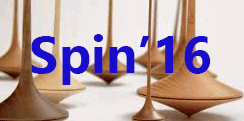Conveners
Plenary: Welcome, Organization and Plenary I
- Naomi Makins (University of Illinois)
Plenary: Plenary II
- Caroline Kathrin Riedl (Univ. Illinois at Urbana-Champaign (US))
Plenary: Plenary III
- Erhard Steffens (University of Erlangen-Nürnberg)
Plenary: Plenary IV
- Franco Bradamante (Universita e INFN, Trieste (IT))
Plenary: Plenary V
- Mauro Anselmino (Torino University and INFN)
Plenary: Plenary VI
- elke-caroline Aschenauer (BNL)
Plenary: Plenary VII
- Donald Crabb (University of Virginia)
Plenary: Plenary VIII
- Paolo Lenisa (University of Ferrara and INFN)
Plenary: Plenary IX
- Anna Martin (Trieste University and INFN (IT))
Plenary: Plenary X
- Hideto Enyo (RIKEN Nishina Center for Accelerator-Based Science)
Plenary: Plenary XI
- Alan Krisch (University of Michigan)
The Electric Dipole Moment (EDM) of the neutron is a probe for the violations in the combined Charge-conjugate and Parity reversal symmetry (CP). Many new theories beyond the Standard Model, which aim to unify the fundamental forces and solve the problem of Baryon Asymmetry of the Universe, also predict sizable EDM just lurking around the corner for discovery. Experimental search for the...
The Revolution to our view of nucleon structure and the glue.
The 2015 nuclear physics long-range plan endorsed the realization of an electron-ion collider as the next large construction project after FRIB. The electron-ion collider with its high luminosity (>10^33 cm−2s−1), wide kinematic reach in center-of-mass-energy (20 GeV to 145 GeV) and high lepton and proton beam polarization provides...
The final nuclear physics experiments with “6 GeV CEBAF” were conducted in 2012 at which point
the accelerator complex was upgraded to double the beam energy and add a fourth experimental
hall. The accelerator upgrade was split into two periods, a six month period preceding the final 6 GeV
operations and an 18 month period post 6 GeV operations. Following completion of the upgrade work,
the...
Spin observables in nuclear structure and reaction studies have played a critical role in characterizing the nature of the nuclear force and dynamics. It is now well established that properties of nuclei at the limits of stability are very different from those found near the stability, representing the need to redefine the paradigms of nuclear structure physics. One such example can be found...
We have carried out calculations demonstrating the benefits of having spin polarized
fuel in future tokamak fusion reactors and the viability of testing spin polarized
fuel in current tokamaks. The cross section for D-T (deuterium-tritium)
fusion is increased by 50% when the nuclei spins are parallel to the tokamak
guide field. In future magnetic confinement fusion reactor power plants...
The A2 Collaboration at the Mainz Microtron MAMI measures photon absorption
cross sections using circularly and linearly polarized ’Bremsstrahlung’
photons up to an energy of 1.5 GeV and a polarized Frozen Spin Target. We
use a 4 π detection system with the ’Crystal Ball’ as central part.
One important experimental topic is the investigation of the baryons excitation
spectrum. Measurements...
In spite of its apparent simplicity, the Drell-Yan process continues to attract increasing levels of interest both in experiment and theory. Spin dependent Drell-Yan scattering provides unique access to transverse momentum dependent distribution functions of the nucleon, while the parton structure of unstable mesons can be probed from the unpolarized Drell Yan case.
Drell-Yan scattering...
A fixed-target experiment using the LHC beams (AFTER@LHC) with a polarized target offers a unique opportunity to study the transverse spin structure of a polarized nucleon in a wide kinematical range. Recent studies have shown that a number of single transverse-spin asymmetries (STSA) are large enough to be precisely measured in the kinematical region accessible with AFTER@LHC, in particular...
We review the recent progress on what is known about the transverse spin structure of hadrons, in particular from observables that can be analyzed within a collinear framework. These effects have been around for 40 years and represent a critical test of perturbative QCD. We look at both proton-proton and electron-nucleon collisions for various final states. While the main focus is on...
Frozen spin polarized targets are perhaps the most complex and demanding target systems used in nuclear and particle experiments. The scattering sample is polarized in a very high magnetic field and at a sub-kelvin temperature, before being cooled to an even lower, millikelvin temperature for data taking. In some examples, the polarization and data acquisition even occur in different...
The Polarized Electrons for Polarized Positrons (PEPPo) experiment at the injector of the Continuous Electron Beam Accelerator Facility has demonstrated for the first time the efficient transfer of polarization from electrons to positrons produced by the polarized bremsstrahlung radiation induced by a polarized electron beam in a high-Z target.
A dedicated 3m long beam line was installed for...
I will review recent theoretical progress in our understanding of the longitudinal structure of the proton. My focus will be on the framework provided by perturbative quantum chromodynamics, and will include a discussion on the determination of helicity-dependent, collinear, parton distribution functions. Connections with nonperturbative models of nucleon structure will also be outlined. I...
The current understanding of the nucleon helicity structure will be reviewed based on the recent results from the Deep Inelastic Scattering experiments at DESY (HERMES), CERN (COMPASS) and Jefferson Laboratory, and polarized proton-proton collisions at RHIC. The advent of high luminosity and high center-of-mass energy Electron Ion Collider (EIC) will open new era in the nucleon helicity...
The measurement of the violation of parity symmetry in electron scattering has proven to be a powerful technique for exploring nuclear matter and for the search for new fundamental forces. A successful history of measurements has set the stage for a series of ultra high-precision measurements, to be made over the next decade, which will test the completeness of the Standard Model description...
